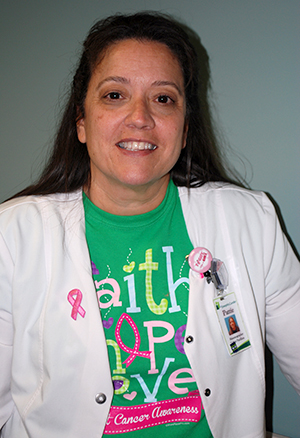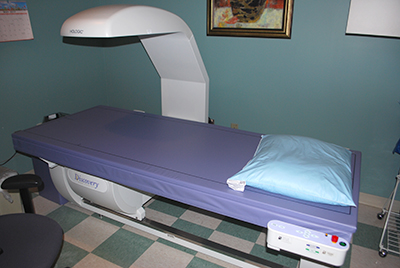Another reason to avoid soda: Help prevent osteoporosis
Orthopedics, Women's Care
Here’s why you should practice good bone health at every age
When you think of osteoporosis, do you tend to associate the disease with elderly women?
Osteoporosis is extremely common in women over 65; however, weakening and brittle bones is something people of all ages should take seriously.
Osteoporosis is a bone disease that occurs when the body loses too much bone, makes too little bone or both. A healthy bone looks like a honeycomb. When osteoporosis happens, the holes and spaces in the “honeycomb” are much larger than in a healthy bone. Osteoporosis may result in broken bones, back pain, loss of height, stooped posture and a curved upper back.

“Osteoporosis should be taken very seriously, especially as people continue to live longer,” says Pattie Barnes, RT(R)(M)(BS) with the St. Joseph’s/Candler Telfair Pavilion. “Almost every woman is at risk of fracturing a hip if they are osteoporotic. Just a normal fall can fracture a hip. That’s the easiest and worst thing that you can have is a fracture.”
About 54 million Americans have osteoporosis and low bone mass, according to the National Osteoporosis Foundation. Studies suggest approximately one in two women and up to one in four men age 50 and older will break a bone due to osteoporosis.
The risk of osteoporosis increases with age as bones naturally become thinner. However, good bone health should be practiced throughout life to help prevent osteoporosis and osteopenia – when your bone density is lower than normal but not low enough to be osteoporotic.
Here’s an age breakdown:
- During childhood and teen years, new bone tissue is added faster than existing bone is absorbed and as a result your bones become larger and heavier.
- Your 20s are a great time to start or maintain regularly exercise routines and a healthy diet that consists of calcium, phosphorus and vitamin D, Barnes says.
- At about age 30, your bone mass density reaches its peak, and by age 40, we slowly begin to lose bone mass, according to the American Academy of Orthopedic Surgeons.
- Because less bone is replaced after age 40, maintaining a regular exercise routine and a healthy diet is crucial to minimizing bone loss.
- Most women between the ages of 50-55 should start bi-annually Bone Mineral Density Test. The test assesses the strength of bones and risk of fractures to determine your chances of developing osteoporosis, says Barnes.
- Osteoporosis can occur in men and women at any age; however, among people 50 and older, 55% are at significant risk for osteoporosis.
What increases your risk of developing osteoporosis
It’s natural for your bones to become thinner. However, whether you develop osteoporosis depends on the thickness of bones early in life and health, diet and exercise later in life.
Here are some factors that can increase your risk of osteoporosis:
- Having a family history of osteoporosis
- Smoking
- Heavy alcohol use
- Getting little or no exercise
- Being small framed or thin (including a history of anorexia and bulimia)
- A diet low in foods containing calcium, phosphorus and Vitamin D
- Having certain medical conditions, such as hypothyroidism or rheumatoid arthritis
- Taking certain medications
- Soft drink intake
“A lot of people don’t know this but soft drinks have a huge effect on bone density,” Barnes said. “Studies show a link between women’s low bone thickness and drinking three or more sodas per day.”
The phosphoric acid in soda (usually 44 to 62 milligrams in 12 ounces) can interfere with bone absorption of calcium.
Bone Mineral Density Test
Several of St. Joseph’s/Candler imaging centers offer a bone scan called the Bone Mineral Density Test.

The test measures the bone density of the cortical bone (spine or forearm) and cancellous bone (hip). It is a painless, non-invasive and safe scan. The test results in a T-score and Z-score. The T-score compares your bone mineral density (BMD) to the peak of a 30-year-old healthy adult of your sex. The Z-score compares your BMD to someone of your age, weight, height, and ethnic or racial origin.
T-score results are:
- Above -1.0: Bone mass is about normal
- -1.0: Bone mass is about 10% below normal
- -1.5: Bone mass is about 15% below normal
- -2.0: Bone mass is about 30% below normal.
- -2.5 or less: You are osteoporotic
If your Z-score is -2 or lower it may mean something other than aging is causing abnormal bone loss.
“(Bone Mineral Density Testing) wasn’t popular a long time ago, but now our schedule is getting fuller and fuller,” Barnes says. “Bone density is really something you want to pay attention to.”
Related Article: What is a DEXA scan?
The scan is recommended for both men and women starting at the age of 50-55. Medicare and most insurance providers mandate a scan every two years, unless you are currently taking medication for bone density loss, and then a yearly scanning is recommended. The appointment takes between 15 and 30 minutes.
Bone density testing is available at the Telfair Pavilion at Candler Hospital, SJ/C Imaging Center – Pooler, SJ/C Imaging Center - Bluffton, Telfair Breast Imaging Center – Eisenhower. For more information or to schedule your appointment, call 912-819-7000 (Telfair Pavilion), 912-748-0068 (Pooler), 843-836-4300 (Bluffton) or 912-691-1460 (Eisenhower).